Sea snake facts for kids
Quick facts for kids Sea snake
|
|
|---|---|
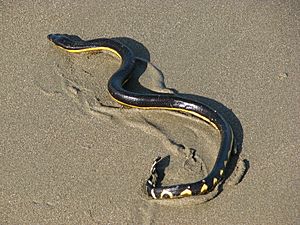 |
|
| Yellow-bellied sea snake (Hydrophis platurus) on a beach in Costa Rica | |
| Scientific classification | |
| Kingdom: | Animalia |
| Phylum: | Chordata |
| Class: | Reptilia |
| Order: | Squamata |
| Suborder: | Serpentes |
| Family: | Elapidae |
| Subfamily: | Hydrophiinae |
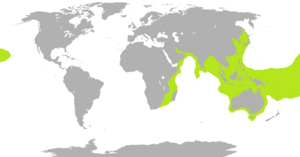 |
|
| Range of sea snakes shown in lime green, except the widespread, pelagic yellow-bellied sea snake | |
Sea snakes are special snakes that live mostly or entirely in the ocean. They are part of a group called elapids, which includes many venomous snakes on land. There are two main types of sea snakes: the Hydrophiinae and the Laticaudinae. The Hydrophiinae group also has some land snakes from Australia. The Laticaudinae group only has sea kraits.
Most sea snakes are venomous, meaning they have poison. However, one type, Emydocephalus, mainly eats fish eggs and is not venomous. Sea snakes are very good at living in water. Most cannot move well on land at all. Sea kraits are different; they can move a little on land. You can find sea snakes in warm coastal waters from the Indian Ocean to the Pacific Ocean. They are closely related to venomous land snakes in Australia.
All sea snakes have tails that look like paddles. Many also have flat bodies, which makes them look a bit like eels. Unlike fish, they do not have gills. This means they must come to the surface to breathe air. Sea snakes are among the animals that live almost completely in water but still breathe air. Some sea snakes have very strong venom. Some are calm and only bite if bothered. Others can be more aggressive.
Contents
What Do Sea Snakes Look Like?
Most adult sea snakes grow to be about 120 to 150 centimeters (4 to 5 feet) long. The biggest one, Hydrophis spiralis, can reach up to 3 meters (10 feet) long! Their eyes are small, and their nostrils are usually on top of their heads. Their skulls are similar to land snakes. They have short fangs and many smaller teeth behind them.
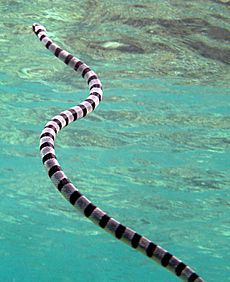
Most sea snakes are fully aquatic. This means they live their whole lives in the water. They have paddle-like tails that help them swim very well. Many species have flat bodies, especially those that live in the open ocean. This means their belly scales are very small. Because of this, they can barely move on land. But since they live only in the sea, they do not need to leave the water.
The only type of sea snake that still has large belly scales is the sea krait, Laticauda. There are five species of sea kraits. These snakes are thought to be more "old-fashioned" because they still spend time on land. Their large belly scales help them grip the ground. Sea kraits are also the only sea snakes whose nostrils are not on top of their heads.
A snake's tongue helps it smell. Underwater, the tongue works differently. Sea snakes have short tongues that only poke out a little bit. Their nostrils have special tissue that keeps water out. Their windpipe can move up to the roof of their mouth. This helps them breathe even if their head is partly underwater. Their lung is very long, almost the length of their body. The back part of the lung might help them float. It also helps them store air for long dives.
Most sea snakes can also breathe through their skin. This is unusual for reptiles because their skin is thick. Studies show that the yellow-bellied sea snake can get about 25% of its oxygen through its skin. This helps them stay underwater for a long time.
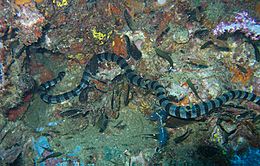
Like other animals that live in the ocean, sea snakes take in a lot of salt. This happens when they eat or accidentally swallow seawater. To handle this, they have special glands under their tongue. These glands help them get rid of extra salt when they move their tongue.
Sea snake scales vary a lot. Land snakes have overlapping scales to protect them. Most open-ocean sea snakes do not have overlapping scales. But sea snakes that live near coral reefs, like Aipysurus, do have overlapping scales. This protects them from the sharp coral. Their scales can be smooth, bumpy, spiny, or look like warts.
How Do Sea Snakes Sense the World?
For land snakes, sight, smell (using their tongue), and hearing are very important. But these senses change underwater. It is hard to see clearly, chemicals spread out, and ground vibrations are limited. This means sea snakes might have special ways to sense things.
We do not know much about sea snake vision. Some studies show they have special cells in their eyes to see light. But vision seems less important for finding food or mates. Sound vibrations and smell might be more important. Some sea snakes have tiny sensory organs on their heads. These might help them feel the movement of fish nearby.
The olive sea snake (Aipysurus laevis) has light-sensing cells in its tail skin. This helps it know if its tail is fully hidden inside coral holes during the day. Other sea snakes might have this ability too.
Scientists have suggested other senses for sea snakes, like feeling electricity or pressure changes. But more research is needed to confirm these ideas.
Where Do Sea Snakes Live?
Sea snakes mostly live in the warm, tropical waters of the Indian Ocean and the western Pacific Ocean. Some species are found far out in Oceania. One species, the yellow-bellied sea snake (Pelamis platurus), lives in more places than almost any other reptile. It is found from the east coast of Africa, across the Indian Ocean and Pacific, down to northern New Zealand, and all the way to the western coast of the Americas. It has been seen as far north as San Diego in the United States.
Sea snakes are not found in the Atlantic Ocean. Cold currents off Namibia and western South Africa stop them from crossing into the South Atlantic. They also do not live in the Red Sea, likely because it is too salty. This means they cannot cross through the Suez Canal. The Panama Canal also keeps them out of the Caribbean because the water there is not salty enough for them.
Even though they live in the ocean, most sea snakes prefer shallow waters near land. They like areas around islands and sheltered places, like near river mouths. Some can even swim up rivers, as far as 160 kilometers (100 miles) from the sea. Others, like P. platurus, live in the open ocean. They can be found in lines of floating debris carried by currents. Some sea snakes live in mangrove swamps and brackish water. There are even two types that live in freshwater lakes: Hydrophis semperi in Taal Lake in the Philippines, and Laticauda crockeri in Lake Te Nggano in the Solomon Islands.
Behavior of Sea Snakes
Sea snakes are usually not eager to bite. They are often thought of as calm animals. But how calm they are can depend on the species and the individual snake. Some species, like P. platurus, use their venom more for defense. They might bite if they feel threatened. Other species, like Laticauda types, use their venom to catch their prey. Fishermen often handle sea snakes without getting bitten when the snakes get caught in nets. However, some species, like Aipysurus laevis and Enhydrina schistosa, are known to be more aggressive.
On land, sea snakes move very strangely. They crawl awkwardly and can become aggressive. They might strike wildly at anything that moves. But they cannot coil up and strike like land snakes.
Sea snakes are active both day and night. In the morning and late afternoon, you might see them floating on the surface, warming up in the sun. They dive underwater if they are disturbed. They have been seen swimming deeper than 90 meters (300 feet). They can stay underwater for several hours, depending on the temperature and how active they are.
Sometimes, huge numbers of sea snakes are seen together. In 1932, a ship reported seeing millions of Astrotia stokesii in the Strait of Malacca. These snakes formed a line about 3 meters (10 feet) wide and 100 kilometers (60 miles) long! No one knows exactly why this happens, but it might be related to reproduction. They can also be seen swimming in groups of hundreds. Many dead sea snakes have been found on beaches after big storms like typhoons.
What Do Sea Snakes Eat?
Sea snakes mainly eat small fish. Sometimes, they also eat young octopuses. They often have small barnacles, called sea snake barnacles (Platylepas ophiophila), attached to their skin.
Reproduction and Life Cycle
Most sea snakes give birth to live young in the water. This means the babies are born already developed and ready to live in the ocean. In some species, the babies are quite large, almost half the size of their mother. The only exception is the Laticauda group. These five species lay their eggs on land.
Sea Snake Venom
Like their relatives in the Elapidae family, most sea snakes have very strong venom. However, they rarely inject their venom when they bite. So, bites to humans are not common. For example, the yellow-bellied sea snake (Hydrophis platurus) has venom that is stronger than many land snakes. But even though it is common in the waters off Costa Rica, few people have died from its bites.
Bites that do inject venom are usually not painful at first. You might not even notice the bite. Sometimes, their teeth can stay in the wound. There is usually little or no swelling. Early signs of a serious bite include a headache, a thick-feeling tongue, thirst, sweating, and throwing up. The venom works slowly. Symptoms like muscle aches, stiffness, and tenderness can appear from 30 minutes to several hours after the bite. It can also be painful to stretch the muscles. Later, other symptoms can appear, like drooping eyelids and muscle weakness. If the muscles for swallowing and breathing become weak, it can be very dangerous.
Scientists have studied how strong sea snake venom is. It mainly affects the muscle cells and parts of the kidneys in humans. This means sea snake venom often causes muscle damage or kidney problems, rather than just nerve problems.
Sea Snakes in Captivity
Keeping sea snakes in captivity is very difficult. They are often nervous and do not like to eat. They prefer to hide in dark corners of their tanks. For many years, they were rarely seen in zoos in Western countries. However, some species are regularly displayed in Japanese aquariums. The types of food they eat can limit which species can be kept. Some sea snakes have very specific diets. Also, some species do not like to be handled or even taken out of the water.
Sea kraits (Laticauda species) need a place to get out of the water, usually around 29°C (84°F). They also need a hidden spot underwater. Some species that have done better in captivity include the ringed sea snake (Hydrophis cyanocinctus). This snake eats fish and eels. The yellow-bellied sea snake (Pelamis platurus) has done especially well. It will eat small fish, including goldfish. Keeping them in round tanks, or tanks with rounded corners, helps prevent them from hurting their snouts on the sides.
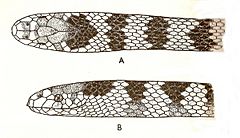
Conservation Status
Most sea snakes are not on special protection lists. However, one species, Laticauda crockeri, is considered vulnerable. Several species of Aipysurus are more at risk. The Timor species, A. fuscus, is endangered. Two other species found north of Australia, the leaf-scaled A. foliosquama and the short-nosed A. apraefrontalis, are critically endangered. This means they are at very high risk of disappearing.
Images for kids
-
Yellow-bellied sea snake (Hydrophis platurus) on a beach in Costa Rica
-
Range of sea snakes shown in lime green, except the widespread, pelagic yellow-bellied sea snake
-
Yellow-lipped sea krait, Laticauda colubrina
-
Blue-lipped sea krait, Laticauda laticaudata
-
Olive sea snake, Aipysurus laevis







